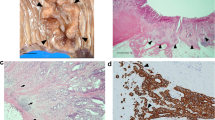Abstract
The potentials of the two major histological types of gastric carcinoma to invade through extracellular matrices were studied with cell lines. We found that the invasive potential of intestinal-type carcinoma cells (MKN-28 and MKN-74) were higher than those of diffuse-type carcinoma cells (MKN-45 and KATO-III). To investigate whether the α2 and α6 integrin adhesion molecules are responsible for, or involved in carcinoma invasion, we further studied α2 and α6 expression patterns in these two types of cell line. Although fluorescence-activated cell sorting analysis revealed that all cells examined invariably expressed these integrin molecules, their expressional patterns were different among different cell lines. The intestinal-type carcinoma cells expressed integrins mainly along the cell-cell contact region, whereas the diffuse-type carcinoma cells showed a diffuse cytoplasmic pattern of integrin expression. Invasion by MKN-28, MKN-74 and MKN-45 cells through reconstituted basement membrane or type I collagen gel was significantly inhibited (P<0.05) by 50 μg/ml anti-(α2 integrin) or anti-(α6 integrin) monoclonal antibodies. Our results suggest that active invasiveness is stronger in the intestinal-type than in the diffuse-type carcinoma cells and that α2 and α6 integrins play important roles in invasion of both types of gastric carcinoma cell lines.
Similar content being viewed by others
References
Alberda SM (1993) Biology of disease, role of integrins and other cell adhesion molecules in tumor progression and metastasis. Lab Invest 68:4–17
Albini A, Iwamoto Y, Kleinman HK, Martin GR, Aaronson SA, Kozlowski JM, McEwan RN (1987) Rapid in vitro assay for quantitating the invasive potential of tumor cells. Cancer Res 47:3239–3245
American Joint Committee on Cancer (1988) Manual for staging of cancer, 3rd edn. Lippincott, Philadelphia, pp 69–74
Baba H, Korenaga D, Haraguchi M, Okamura T, Saito A, Watanabe A (1989) Width of serosal invasion and prognosis in advanced human gastric cancer with special reference to the mode of invasion. Cancer 64:2482–2486
Castronovo V (1993) Laminin receptors and laminin-binding proteins during tumor invasion and metastasis. Invasion Metastasis 13:1–30
Dedhar S, Saulnier R (1990) Alteration in integrin receptor expression on chemically transformed human cells: specific enhancement of laminin and collagen receptor complexes. J Cell Biol 110:481–489
Duoarte I, Llanos O (1981) Pattern of metastases in intestinal and diffuse types of carcinoma of the stomach. Hum Pathol 12:237–242
Hendrix MJC, Seftor EA, Seftor REB, Fidler IJ (1987) A simple quantitative assay for studying the invasive potential of high and low human metastatic variants. Cancer Lett 38:137–147
Hirota T, Ochiai A, Itabashi M, Maruyama K (1991) Significance of histologic type of gastric carcinoma as a prognostic factor (in Japanese). Stomach Intest 26:1149–1158
Hsu S-M, Raine L, Fanger H (1981) Use of avidin-biotin-peroxidase complex (ABC) in immunoperoxidase techniques: a comparison between ABC and unlabeled antibody (PAP) procedure. J Histochem Cytochem 29:577–580
Hynes RO (1987) Integrins: a family of cell surface receptors. Cell 48:549–554
Hynes RO (1992) Integrins: versatility, modulation, and signaling in cell adhesion. Cell 69:11–25
Koike N, Saitoh K, Todoroki T, Fukao K, Watanabe T, Nakamura K (1994) Immunohistochemical study of VLA integrins in human gastric carcinoma (in Japanese). Jpn J Gastroenterol 91:2183–2192
Koretz K, Schlag P, Boumsell L, Möler P (1991) Expression of VLA-α2, VLA-α6 and VLA-α2 and β1 chains in normal mucosa and adenomas of the colon, and in colon carcinomas and their liver metastasis. Am J Pathol 138:741–751
Lauren P (1965) The two histological main types of gastric carcinoma: diffuse and so-called intestinal-type carcinoma. Acta Pathol Microbiol Scand 64:31–49
Liotta LA (1986) Tumor invasion and metastasis-role of the extracellular matrix: Rhoads memorial awards lecture. Cancer Res 46:1–7
Motoyama T, Hojo H, Watanabe H (1986) Comparison of seven cell lines derived from human gastric carcinomas. Acta Pathol Jpn 36:65–83
Nakamura K (1990) Structure of the gastric cancer, 2nd edn [in Japanese). Igakushoin, Tokyo, pp 224–228
Nakamura K, Sugano H, Takagi K (1968) Carcinoma of the stomach in incipient phase: its histogenesis and histological appearances. Gann 59:251–258
Pignatelli M, Hanby AM, Stamp GMW (1991) Low expression of β1,α2 and α3 subunits of VLA integrins in malignant mammary tumours. J Pathol 165:25–32
Ruoslahti E (1992) Control of cell motility and tumour invasion by extracellular matrix interactions. Br J Cancer 66:239–242
Smolle J, Soyer HP, Smolle-Juettner F-M, Stettner H, Kerl H (1990) Comparison simulation of tumor cell motility and proliferation. Pathol Res Pract 186:467–472
Weinel RJ, Rosendahl A, Pinschmidt E, Kisker O, Simon B, Santoso S (1995) The α6-integrin receptor in pancreatic carcinoma. Gastroenterology 108:523–532
Yamada KM, Kennedy DW, Yamada SS, Gralnick H, Chen W-T, Akiyama SK (1990) Monoclonal antibody and synthetic peptide inhibitors of human tumor cell migration. Cancer Res 50:4485–4496
Yamada T, Fan J, Shimokama T, Tokunaga O, Watanabe T (1992) Induction of fatty streak-like lesions in vitro using a culture model system simulating arterial intima. Am J Pathol 141:1435–1444
Author information
Authors and Affiliations
Rights and permissions
About this article
Cite this article
Koike, N., Todoroki, T., Komano, H. et al. Invasive potentials of gastric carcinoma cell lines: Role of α2 and α6 integrins in invasion. J Cancer Res Clin Oncol 123, 310–316 (1997). https://doi.org/10.1007/BF01438306
Received:
Accepted:
Issue Date:
DOI: https://doi.org/10.1007/BF01438306




